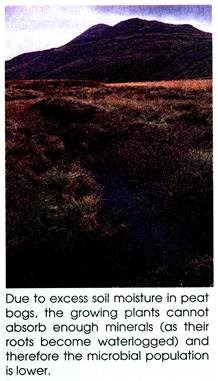ADVERTISEMENTS:
The major external factors that influence the microbial community in soil are: 1. Soil Moisture 2. Organic and Inorganic Chemicals 3. Soil Organic Matter 4. Types of Vegetation and its Growth Stages 5. Different Seasons.
Factor # 1. Soil Moisture:
Moisture is present in the form of film in soil pores. The amount of water increases with increase in porosity of soil. Pore-size depends on soil texture i.e. composition of sand, silt and clays. Moreover, soil moisture is affected through irrigation, drainage or management practices like tillage or crop rotation that enhance the intake and transmission of water by soil.
Factor # 2. Organic and Inorganic Chemicals:
The chemicals are very important for microorganisms as these provide nutrition for growth, activity and survival of microorganisms in ecologically deficient niches in soil. The chemical factors are gases, acids, micro- and macro-elements, clay minerals, etc. In the soil solution gases (oxygen, methane and carbon dioxide), and microorganisms are dissolved.
ADVERTISEMENTS:
However, the dissolved components are in constantly shifting equilibrium with the solid phase, soil air, and moisture as well as with soil organisms and plant root activity. It has been found that low potassium and high nitrogen favour cotton wilt by Fusarium vasinfectum.
Soil-borne fungi are sensitive to pH. As a result of pH range for vigour and growth, they are more destructive at acid and neutral at alkaline conditions.
For example, Plasmodiophora brassicae favours best in acid soil, and the disease produced by it is uncommon or mild in soil of pH more than 7.5. Acidophilic natives of Trichoderma viride increased in soil on addition of sulphur, carbon disulphide, and methylbromide due to lowering down of pH to about 4.0.
Factor # 3. Soil Organic Matter:
The dead organic material of plant and animal origin serve as total soil organic matter which later is subjected to microbial colonization and decomposition. However, upon incorporation of green manures, crop residues, etc. in soil, the community size of microorganisms gets increased.
ADVERTISEMENTS:
At the same time application of these organic matter alters the composition of soil microflora, microfauna, and relative dominance of antagonistic bacteria, actinomycetes, fungi, amoebae, etc.
Factor # 4. Types of Vegetation and its Growth Stages:
The dominance of one or the other groups is related to the type of vegetation and growth stages of a plant. Dubey and Dwivedi (1988) found an increased population of fungi in the non-rhizosphere and rhizosphere of soybean according to season and growth stages, respectively (Table 30.2).
In the rhizosphere aspergilli, fusaria and penicillia were dominant in addition to the other fungal species. However, frequency of Macrophomina phaseolina and Neocosmospora vasinfecta increased on rhizoplane with onset of senescence.
This selective action of plants is attributed to microbial response either to specific root-exudates or chemical constituents of sloughed-off tissues that undergo decomposition. Moreover, Mueller (1985) determined the incidence of fungi and bacteria occurring in the roots of six soybean cultivars growing in fields cropped for 3 years either with corn or soybean.
Cropping history affected the recovery of M. phaseolina, Phomopsis spp. and Trichoderma spp. but not Fusarium spp. or Gliocladium roseum. Recovery of Trichoderma spp. was greater following com than following soybean. After death of the plant soil saprophytes colonize rapidly, thus total spectrum of microflora in the rhizosphere is changed.
Factor # 5. Different Seasons:
The amount of plant available nutrients is governed by the number and activity of microorganisms. They remain in constant dynamic state in soil where microbial community is greatly influenced by physicochemical and biological factors. Changes in microbial community are known in soils of tropical, sub-tropical and temperate regions.
Shail and Dubey (1997) have studied the seasonal changes in microbial community (bacteria and fungi) and species diversity in fungi in banj-oak and chir-pine forest soils of Kumaon Himalaya in relation to edaphic factors. Maximum number of fungal taxa and average number of bacteria and fungi (per gram soil) were recorded in rainy season and minimum in summer season from both the soils (Table 30.3).
Table 30.3 : Seasonal changes in average number of fungi and bacteria per gram dry soil in banj-oak and chir-pine forest soils of himalaya.


